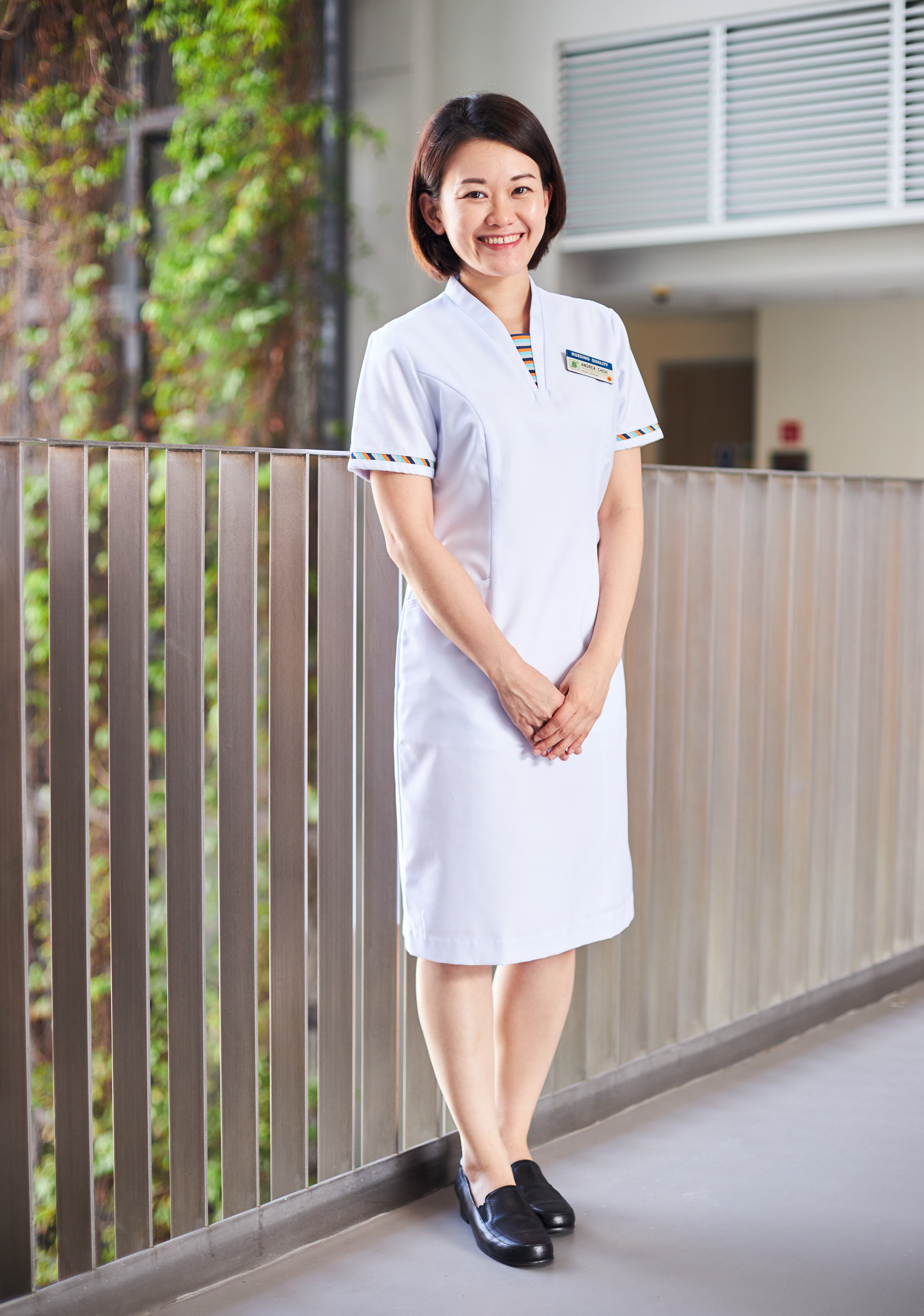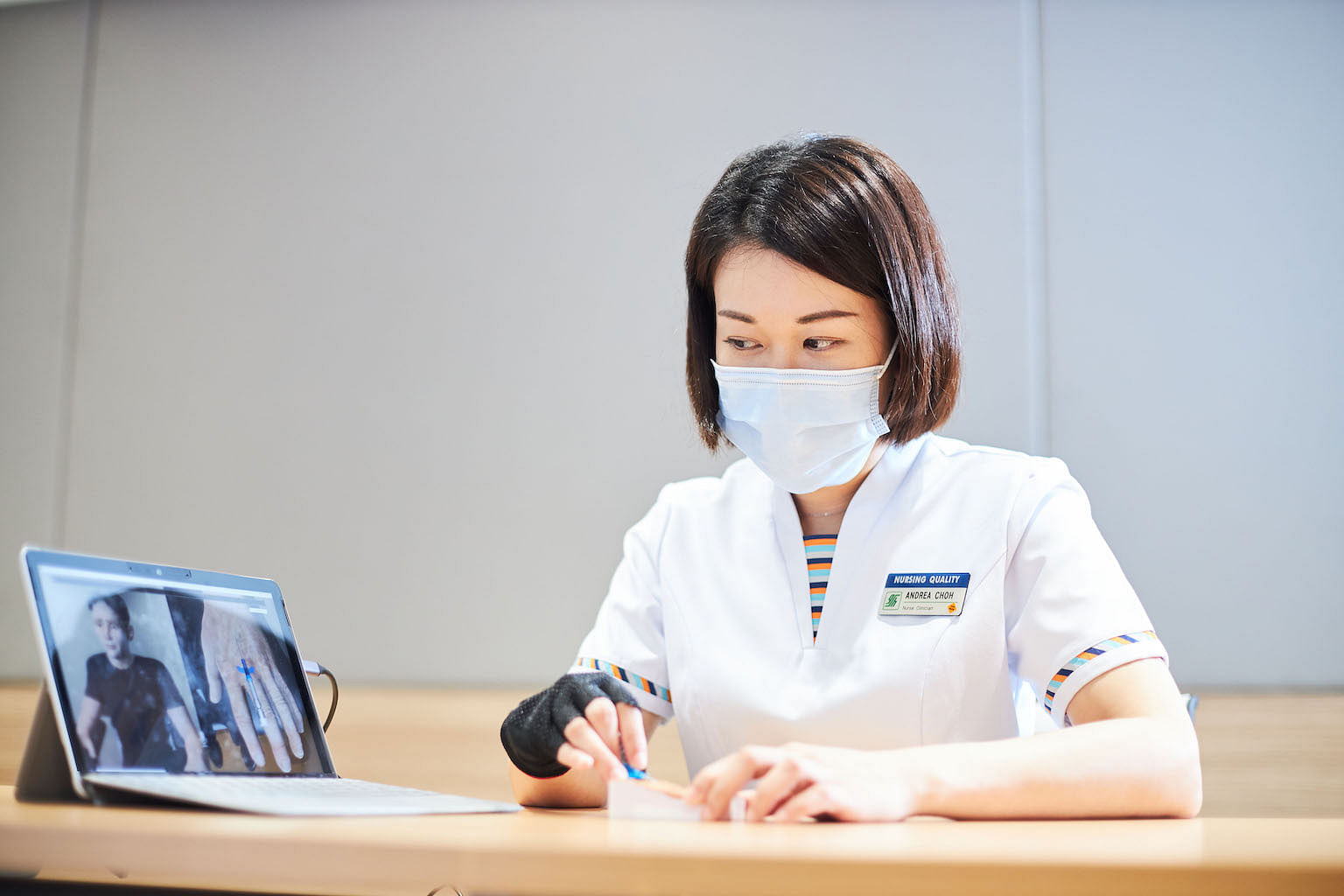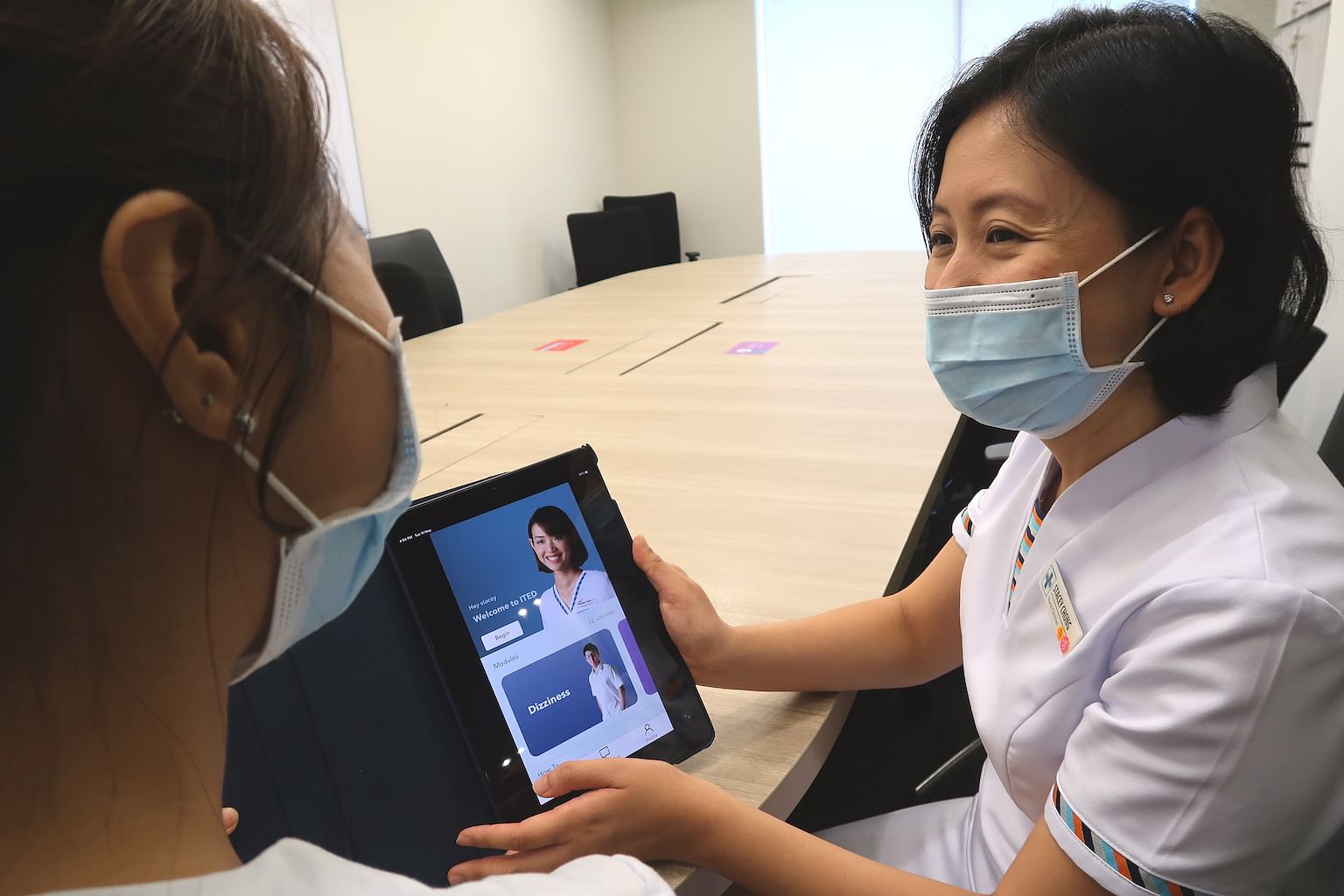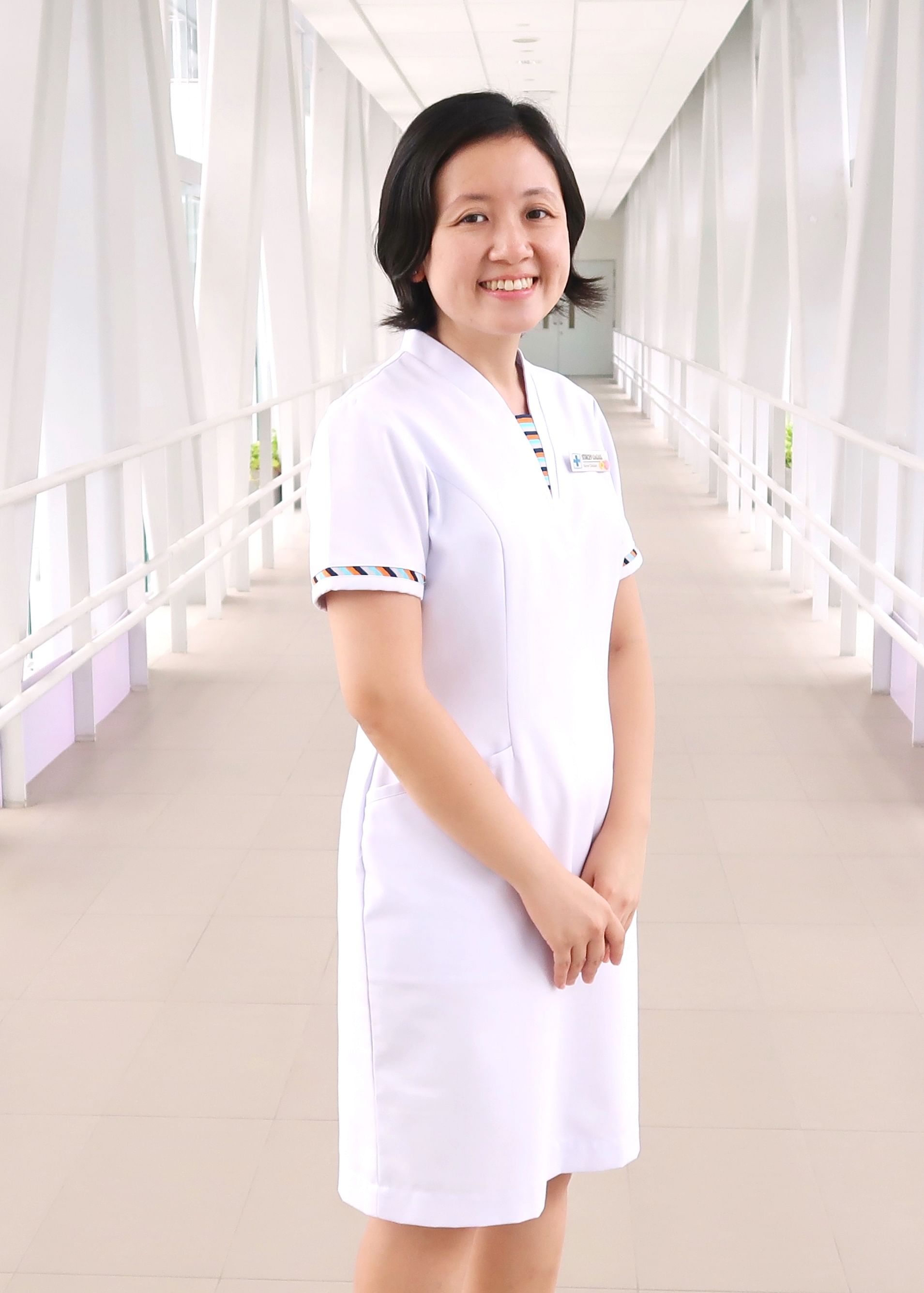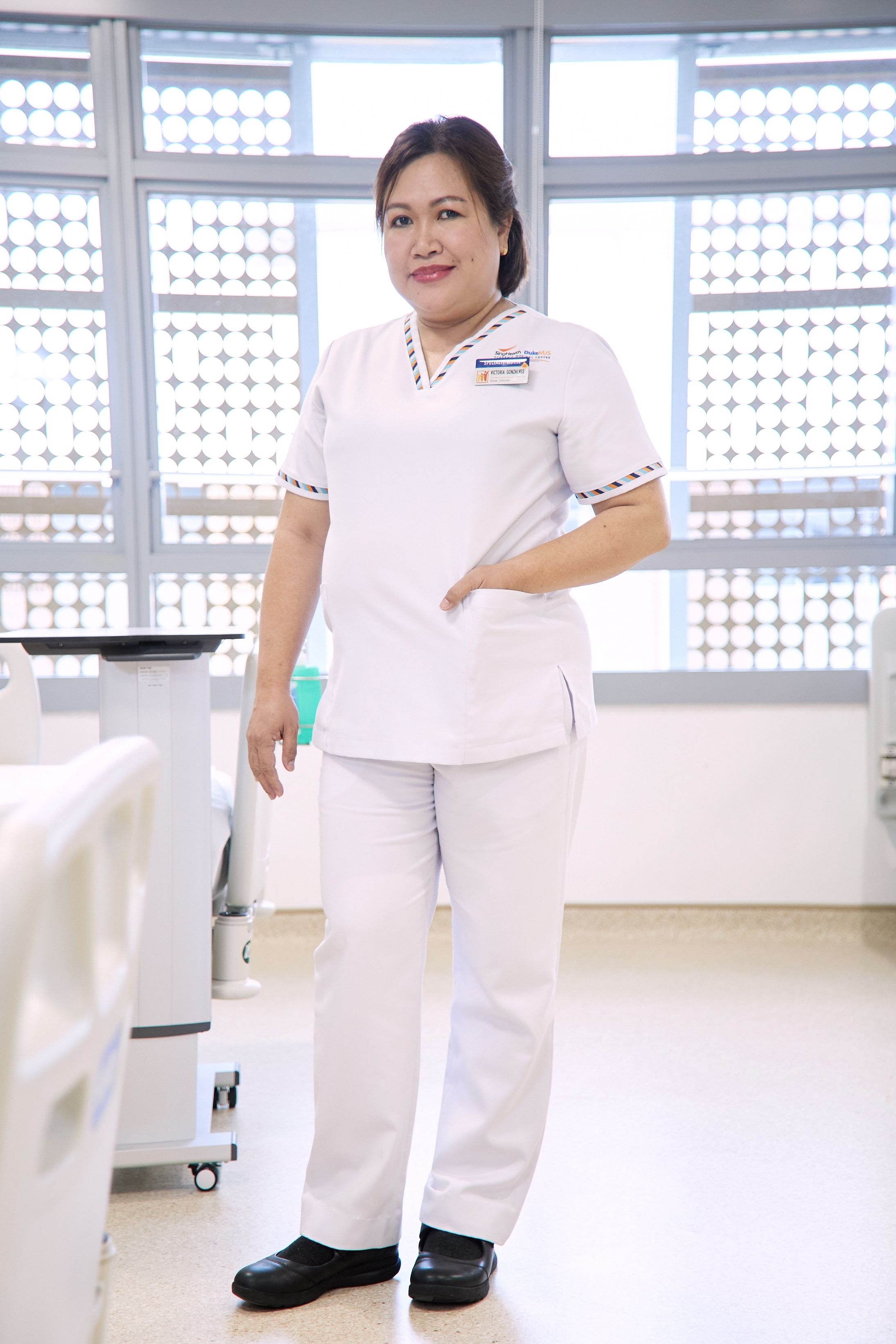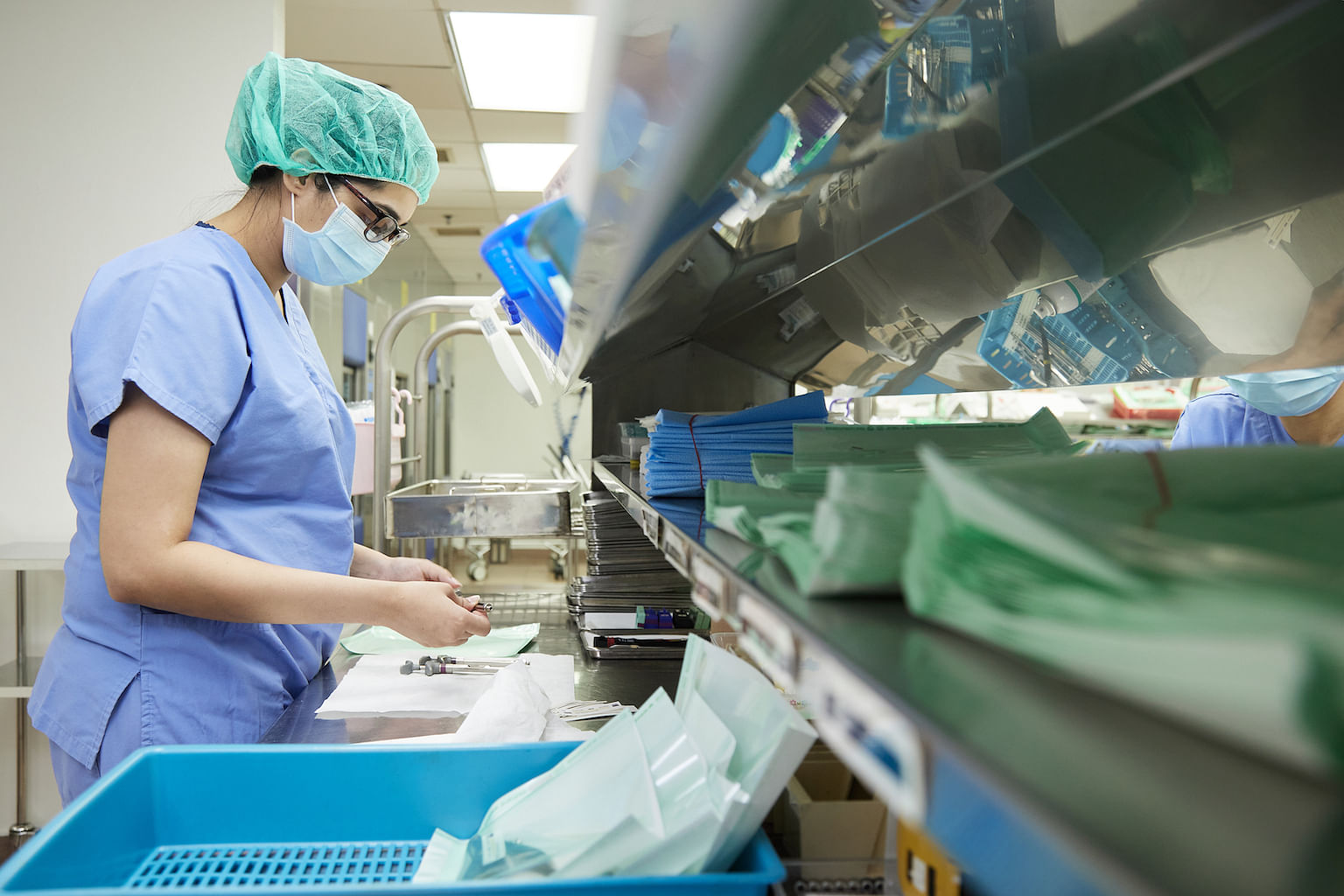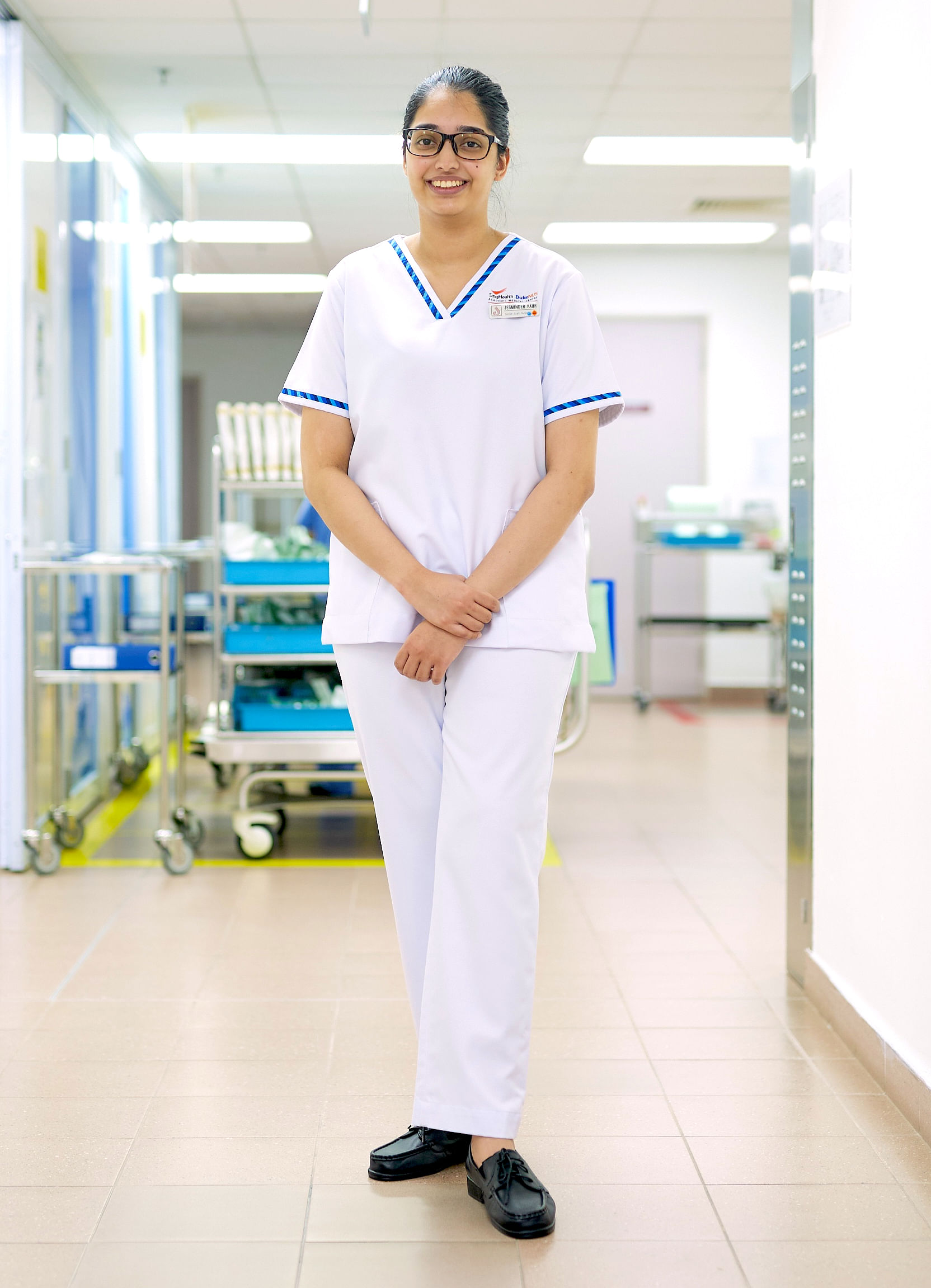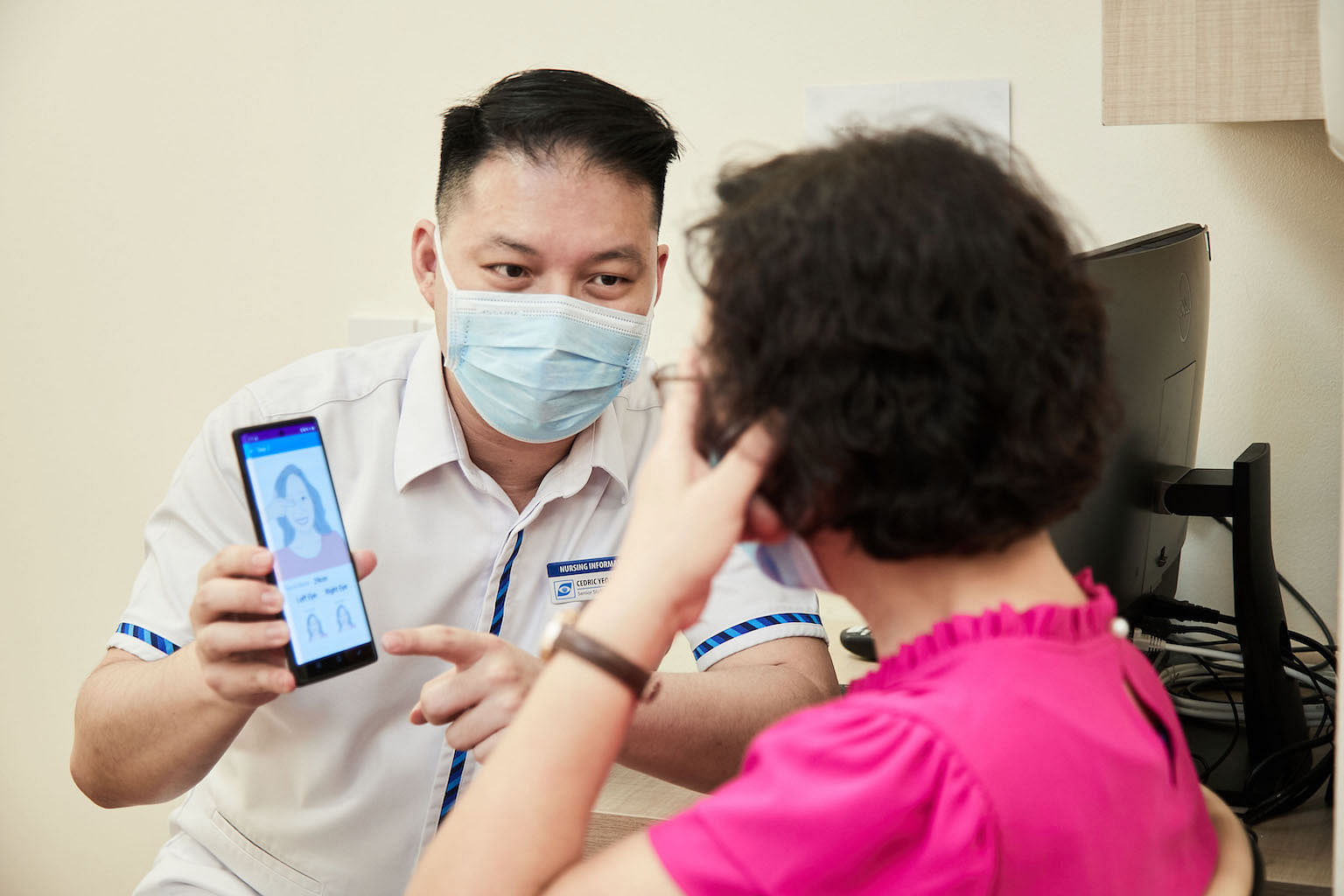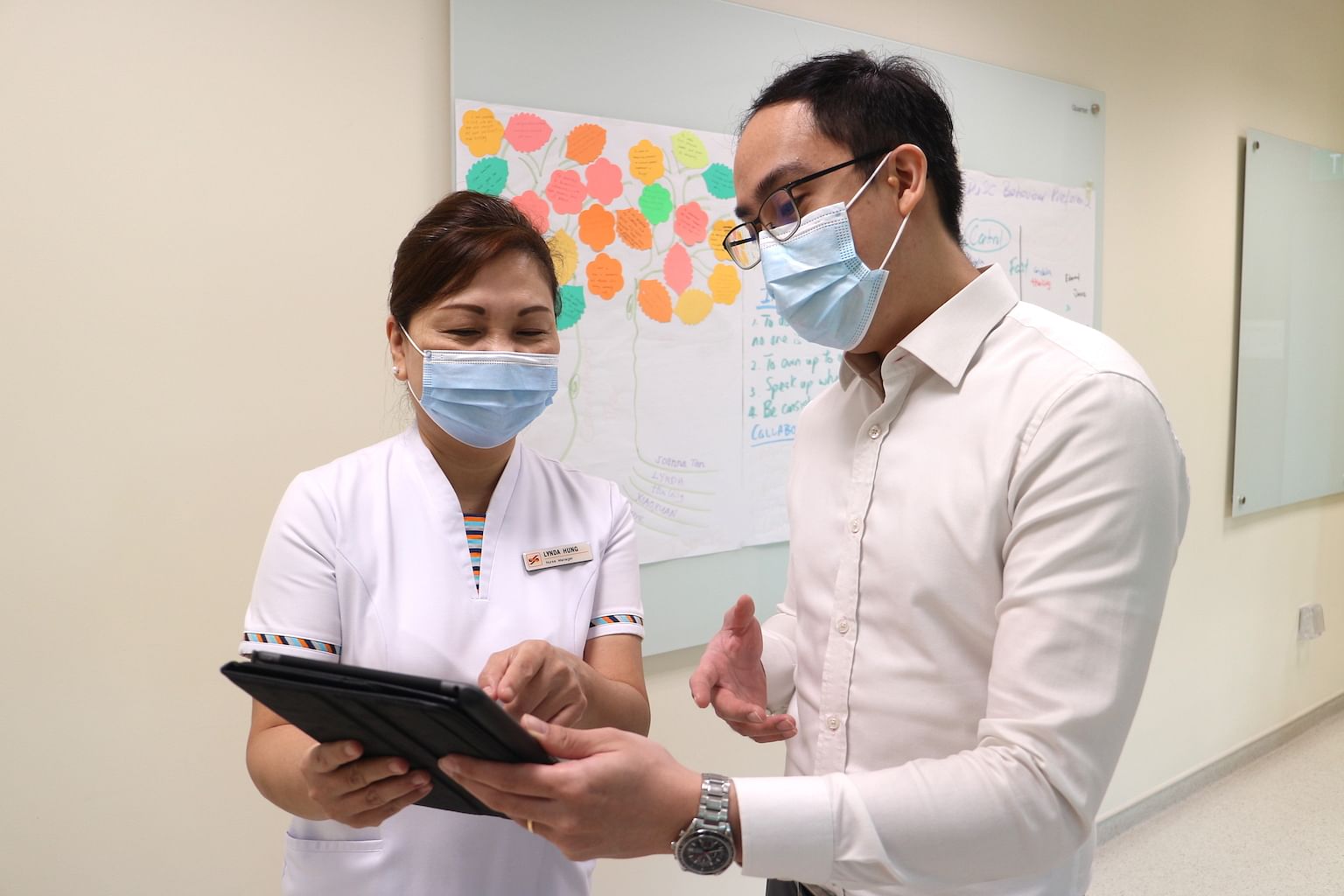Nurses who are also innovators
Andrea Choh Chau Lin
Nurse clinician, Singapore General Hospital (SGH)
Although she has been a nurse for 18 years, Andrea still remembers how nervous she felt when she had to perform her first intravenous (IV) cannulation on a patient. Inserting a cannula, or a thin tube, into the vein to administer a fluid into the bloodstream can make a novice nurse fearful and, if not well done, cause the patient pain.
This motivated Andrea, who is from SGH’s Nursing Quality Management team, and her colleagues from the Institute of Advanced Nursing to revolutionise the training and assessment of new nurses in the procedure.
Devising a serious game to measure physical dexterity is particularly challenging, but in just six months, they developed a prototype that is being piloted on new nurses, and could be deployed more widely by September 2021.
By conversing with a virtual patient, nurses are able to practise healthcare communication and explain procedures and provide reassurance to the patient.
They will then don a glove with a sensor woven into it while performing IV cannulation on a 3D printed arm. This arm is connected to a laptop. The glove can sense the pressure when a cannula is inserted, and the virtual patient will react and respond in real time while the procedure is being carried out. The texture and feel of the arm closely mimic that of a human’s — a significant improvement from the mannequin arm that is currently being used to train nurses.
To make the training more realistic, the team is planning to create various versions to more accurately reflect different patient profiles, such as male or female patients, or those with hard-to-palpate veins. This project was awarded a grant by the Institute of Adult Learning, through the competitive InnovPlus Challenge.
Stacey Chong
Nurse clinician, Changi General Hospital (CGH)
Developing a mobile application was a challenging experience for Stacey, but she is all ready to tackle more apps if they can contribute to educating nurses.
The app she co-developed, called Improving Triage in the Emergency Department (ITED), is on trial at CGH’s Emergency Department (ED) to train and assess new nurses in triage skills.
Triage is a process for ED nurses to prioritise patients according to how urgent and serious their illnesses are. Doing triage competently and accurately, including asking the right questions, ensures that patients in need of urgent attention are seen by doctors quickly and that resources are used efficiently.
Under the guidance of ED doctors and with the support of her peers, Stacey worked with a vendor to build the app. The app includes videos that simulate the conditions of patients in real life. The user then needs to ask the relevant questions that can be used to assess the condition of the patients. The app uses artificial intelligence to simulate patient responses and users will receive real-time feedback on how they fared. The project was awarded the InnovPlus Challenge Award, organised by the Institute of Adult Learning Singapore, which provided a grant to develop the app.
Ma Victoria Dela Cruz Gonzalves
Nurse clinician, Sengkang General Hospital (SKH)
Nurses at SKH used to have to empty urine drainage bags as frequently as every 10 minutes for patients undergoing a procedure called continuous bladder washout (CBWO). This left the nurses little time to handle other tasks.
This changed after Victoria came up with a quality improvement (QI) project that reduced the frequency of emptying the urine drainage bags. This is the initiative she is most proud of among the various QI projects she has undertaken in her 22-year nursing career.
CBWO, which can last up to two days, is commonly performed after bladder or prostate surgery, or to remove and prevent blood clots in the bladder. Blood clots in the bladder can cause much discomfort, impede urination and lead to abdominal distension, and possible kidney damage. The procedure involves continuous irrigation of the bladder by passing saline through a catheter into the bladder, with the outflow collected in a urine drainage bag.
Victoria’s solution was to replace the usual two-litre urine drainage bags with four-litre ones, and her solution was implemented last year. She and her team have gone on to develop a prototype of an automated flow sensor to remotely monitor urine drainage bags and alert nurses when they are close to being filled.
Nurse clinician, Sengkang General Hospital (SKH)
Jesminder Kaur
Senior staff nurse, National Dental Centre Singapore (NDCS)
Faced with the prickly problem of a common dental instrument — known as a periodontal probe — breaking too often, Jesminder decided to do something about it.
The probe, which costs an average of $18 apiece, has to be discarded if its fragile pointed tip breaks. Apart from the cost of replacement, it is time-consuming for staff to check for breakages.
Jesminder co-led a team of fellow Central Sterile Services Department (CSSD) nurses to introduce a series of measures during the cleaning and sterilisation process that successfully reduced the median number of breakages per week at the CSSD from nine to just two. CSSD has also applied these interventions to the handling of other sharp probes and instruments.
Another project that Jesminder co-led in her two years at CSSD was to streamline the process of cleaning equipment trolleys. With the new workflow, the team was able to save on both manpower and utility costs.
Cedric Yeo Shan Jiao
Senior staff nurse, Singapore National Eye Centre (SNEC)
EySee is a mobile application that tests visual acuity and is a brainchild of the SNEC Digital Transformation Office headed by Associate Professor Gavin Tan, a Senior Consultant at SNEC. It is currently in the prototype phase. The idea for such a tool was mooted during the circuit breaker period last year. It aimed to reduce patients’ waiting time at eye clinics and minimise the risk of exposure to Covid-19.
Cedric has been researching the EySee app since March this year in addition to his clinical duties. As a member of SNEC’s Nursing Informatics Department, set up in 2018, he is also involved in recruiting patients for a clinical study to validate the reliability of the app.
The app is expected to be ready for public use by 2022. He and his colleagues have also begun work on other projects, such as a chatbot function to enable patients to ask questions online before and after an eye operation.
Lynda Hung Yit Sim
Nurse manager, SingHealth Polyclinics (SHP)
Tapping into healthcare technology, Lynda worked with engineers on a project to enable patients seeking certain services at SingHealth Polyclinics (SHP) to fill in pre-visit online questionnaires. This has saved time for clinical staff and received positive feedback from users.
The services include cervical cancer screening, antenatal screening, family planning as well as child immunisation and travel medicine vaccination services.
The project required Lynda to first retrieve the relevant questionnaires from the Sunrise Clinical Manager (SCM), an Electronic Medical Record software. She then collaborated with the HealthHub IT team to ensure that responses are successfully transferred to SCM. This significantly improves efficiency as clinical staff no longer need to enter the information manually.
Along with an SMS to remind them of their upcoming appointments, patients are asked to fill in the pre-visit questionnaires via SingHealth’s Health Buddy app, or the Ministry of Health’s HealthHub portal or app before visiting the clinic.
More than 22,000 patients have chosen to fill in these questionnaires since they became available in July 2020. All patients surveyed found them to be useful.
Join ST’s Telegram channel here and get the latest breaking news delivered to you.
Source: Read Full Article
